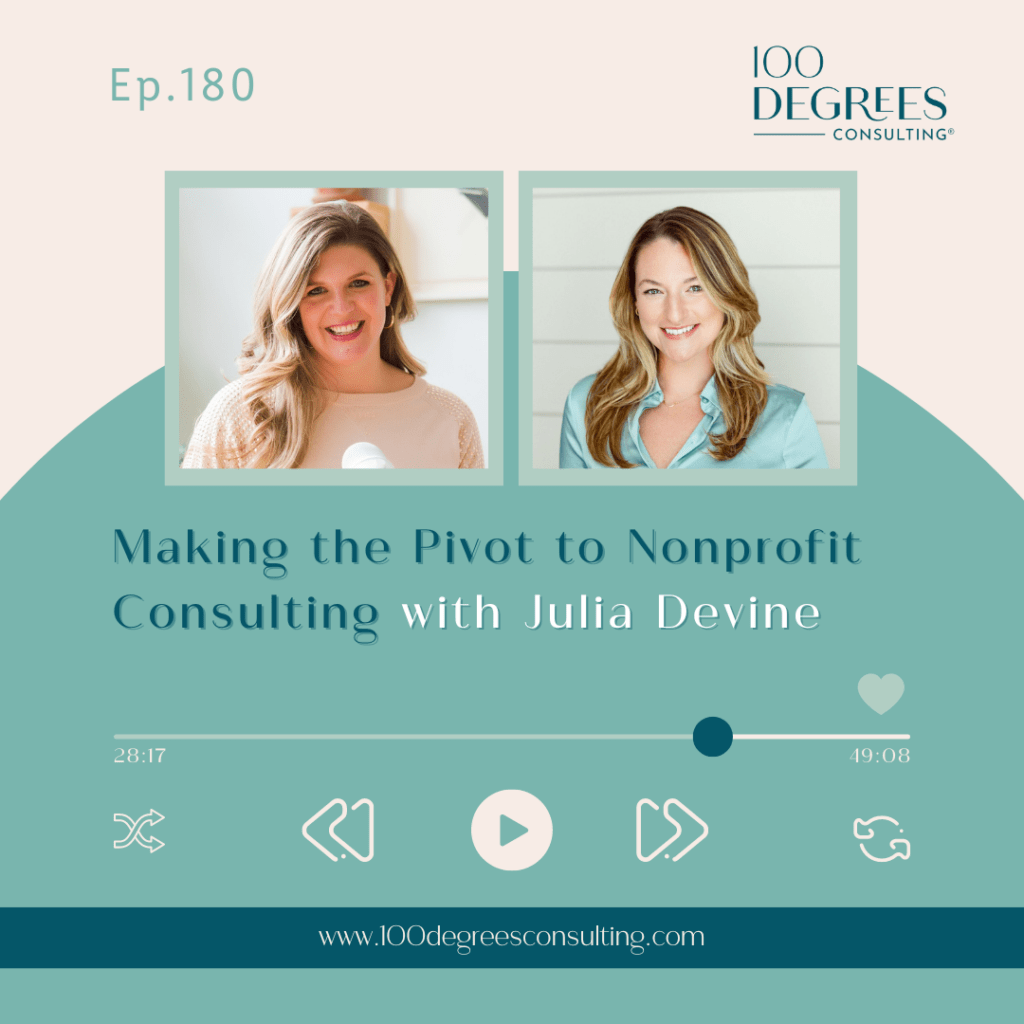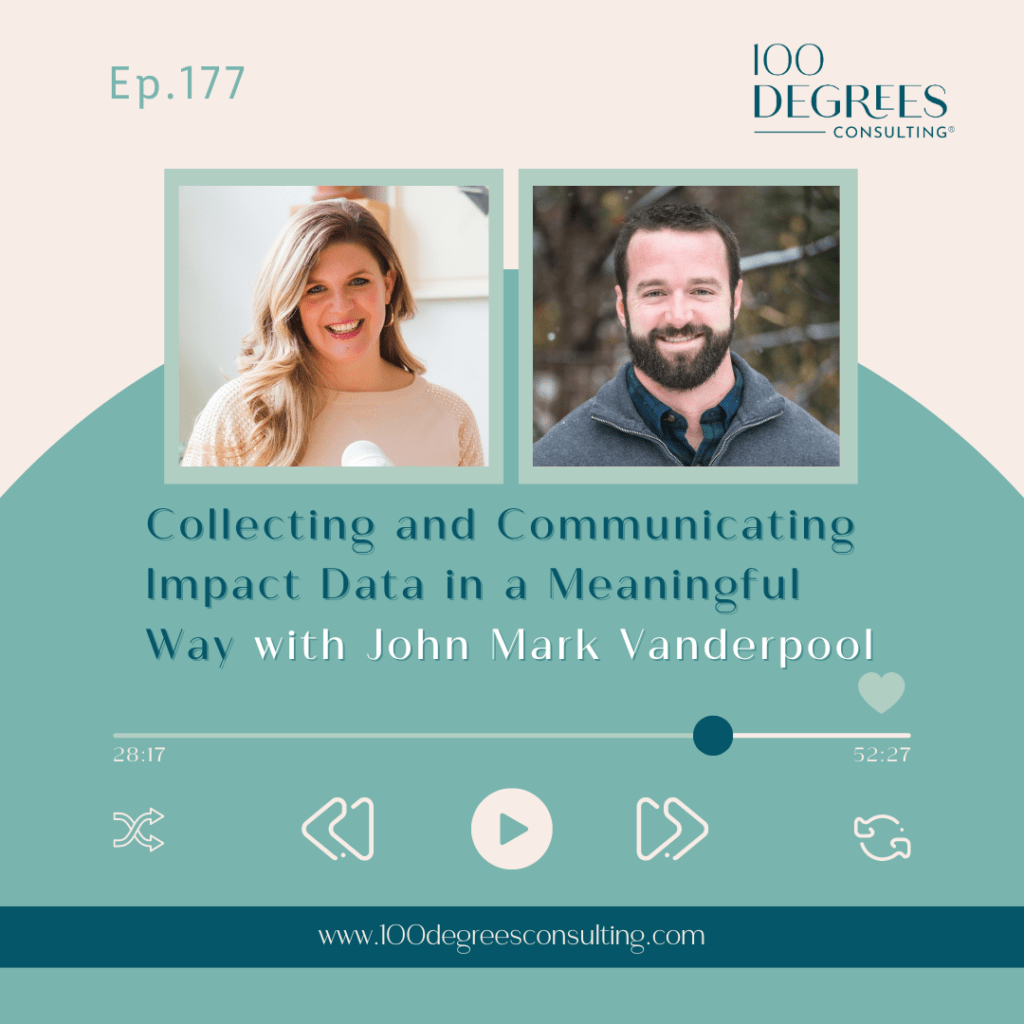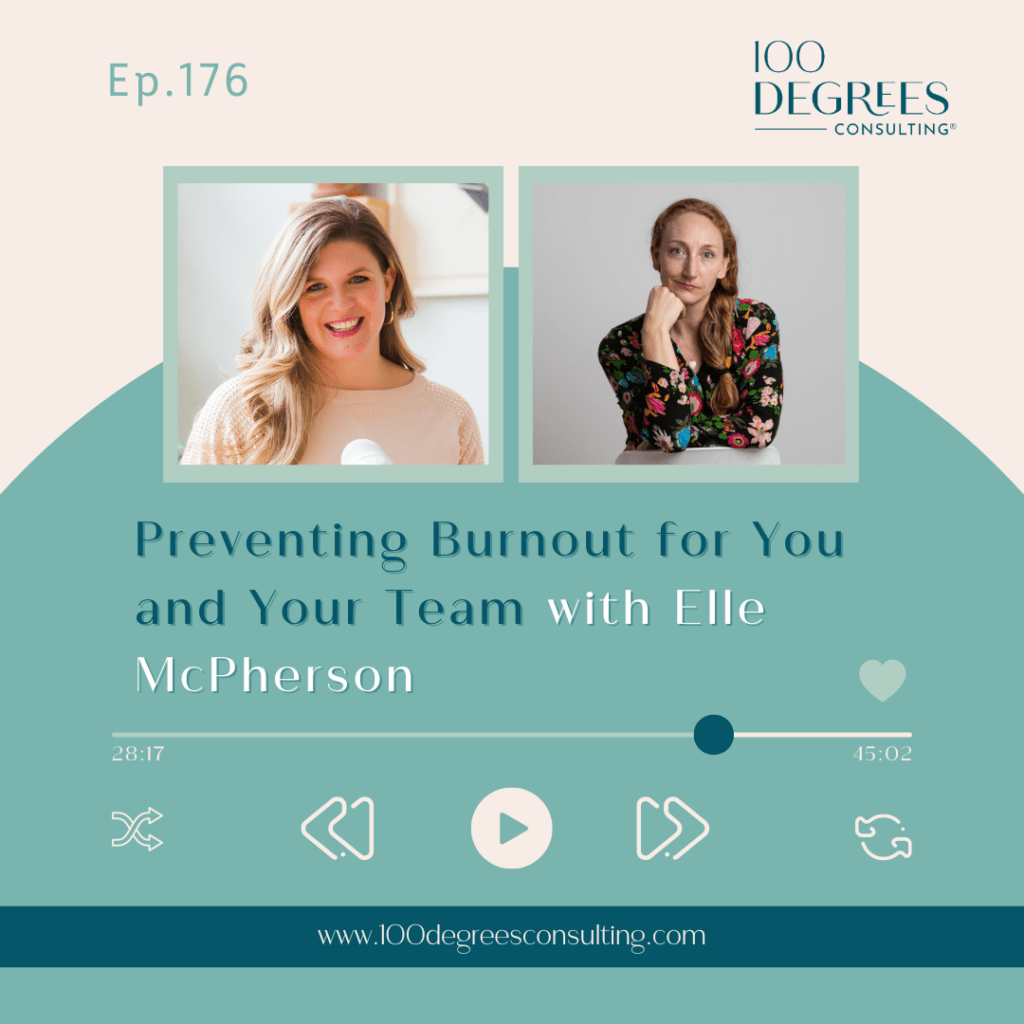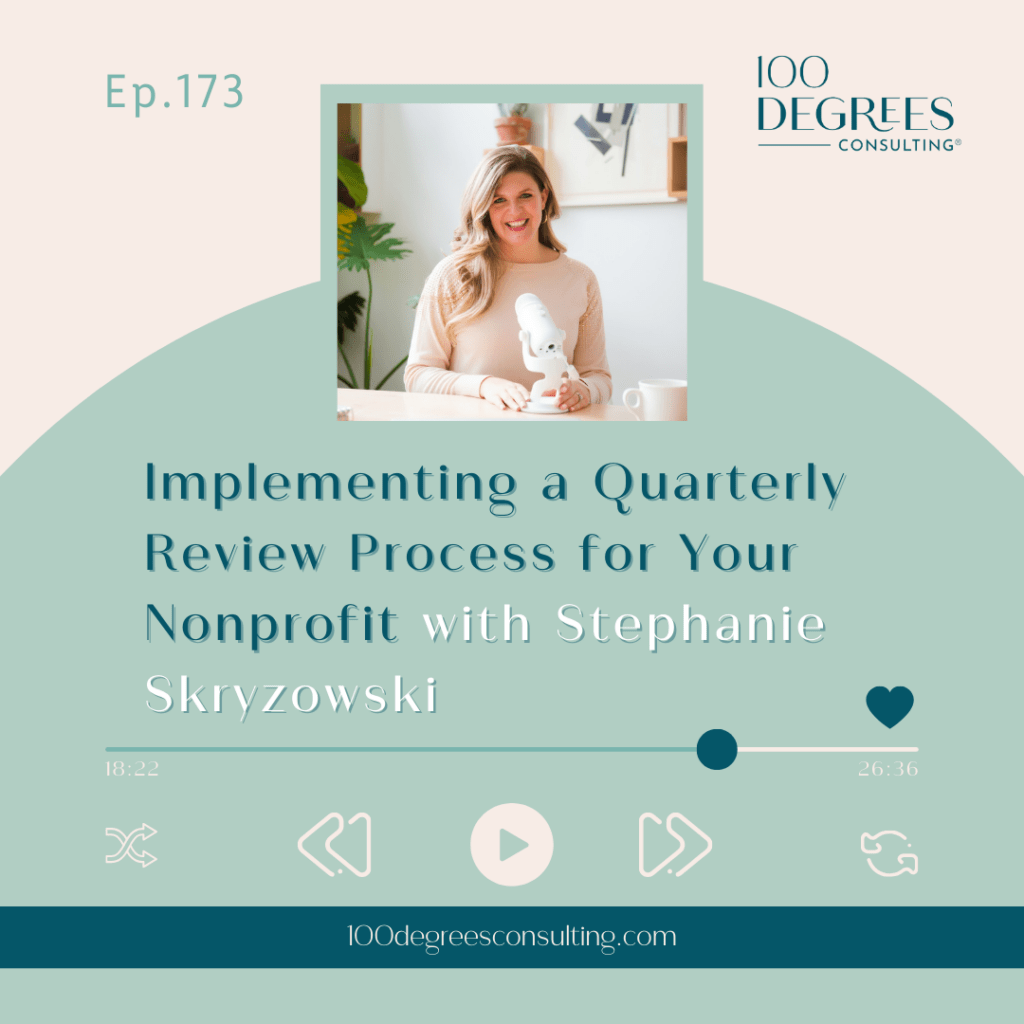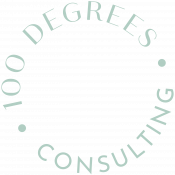Transcript Episode 160 – Scaling Your Nonprofit Using Unique Revenue Streams with Sara Allen on The Prosperous Nonprofit
Stephanie Skryzowski: [00:00:00] Welcome to the Prosperous Nonprofit, the podcast for leaders who are building financially sustainable and impactful nonprofits and changing the world. I’m Stephanie Skrzewski, a chief financial officer and founder and CEO of 100 Degrees Consulting. My personal mission is to empower leaders to better understand their numbers, to grow their impact and their income.
On this show, we talk to people who are leading the nonprofit sector in new. Innovative, disruptive, and entrepreneurial ways, creating organizations that fuel their lives, their hearts, and their communities. Let’s dive in.
Hello, friends. Welcome back to the Prosperous Nonprofit. I am excited to be here with you today and with Sarah Allen. So Sarah and I have known each other and have sort of worked together. She’s been a client of my [00:01:00] company for, I think, almost five years. And I’m really excited for our conversation today because she works for an organization.
It’s a community health clinic. And so she is really operating from the perspective of a business and a nonprofit at the same time. So they are a 501c3 nonprofit that also is. Very businesslike in many qualities. So I think you’re going to find this conversation really interesting, especially if you’ve been thinking about like, okay, how can we diversify our revenue?
What other revenue streams might we have that, you know, maybe we haven’t looked at before we haven’t explored. So I’m excited for you to listen to this. Let me tell you a little bit about Sarah. And then I have a very, very special Offer for you that I want to share before we get started. Okay. So Sarah, as executive director for Sojourns Community Health Clinic, Sarah feels honored to lead a clinic that provides naturopathic primary care, physical therapy, acupuncture, chiropractic massage therapy, and other services to help people [00:02:00] feel whole and well.
Originally from the West Coast and raised on the East Coast, Sarah believes that cohesion can be created across divides. Her sites are set on helping the world to embrace a model of wellness that’s holistic, integrative, compassionate, and effective. Sarah brings to Sojourns over 20 years of experience in organizational development, communications, fundraising, and strategic planning.
Her leadership style enables individuals to realize innate talent and apply it towards a common goal. She lived in Washington DC for 20 years before relocating to New England in 2022. And she has a master’s degree in public communication with a public health focus from American University and then a bachelor’s degree in religion and women’s studies from Duke.
And she’s also a certified life and health coach. And so I really want you to check out sojourns. org, which is the website for their community health clinic. And they have an online store. Um, they have an apothecary at their facility up in Vermont. So if you’re local to Vermont, definitely check out sojourns.
org and go [00:03:00] check them out, but they also now have an online apothecary and Sarah and her team were so generous to share a discount code with us. So if you go to sojournsapothecary. org and check out all of the different supplements and things that they have there. She has given us a discount code, which is PROSPER, P R O S P E R, PROSPER.
If you enter the code PROSPER at checkout, you will receive a discount to your purchase. So we talked specifically about creatine on the podcast, which is funny. I was telling her that my friend just. mentioned creatine to me the other day and so she had mentioned it. I’m like, Oh, I guess I need to, I guess I need to buy some.
And, um, so then she offered this amazing code to all of our listeners. So go to SojournsApothecary. org and use the code PROSPER at checkout for a discount on any of their products that they have. So anyway, without further ado, let’s go talk to Sarah.[00:04:00]
Hey, everybody. Welcome back to the Prosperous Nonprofit. And I am very excited to have with you Sarah Allen. Sarah, welcome. Hi,
Sara Allen: Stephanie. It’s so good to be with you.
Stephanie Skryzowski: Well, I’m super excited to chat with you today. We were just talking before we hit record that we actually started working together nearly five years ago and like the time has totally flown.
So I’m just excited to dive in a little bit more and hear about your journey and your work, but I would love for you to tell us, tell us about the organization that you work for and what your organization does.
Sara Allen: Sure, sure. So I am the executive director for Sojourns Community Health Clinic. We’re located in southern Vermont, and we serve multiple parts of New England with integrative health care services.
So what’s really unique about our clinic is that one, we’re a nonprofit. Two, we’ve got a variety of services within the walls of our clinic. So we have everything from physical therapy. chiropractic, [00:05:00] acupuncture, all the way up to naturopathic and primary care, as well as nurses and also community acupuncture.
So we, it really runs the gamut of what people might need in terms of their health care. And the other thing that makes us unique is that we accept insurance. So that we can serve a broader swath of patients.
Stephanie Skryzowski: That’s so interesting that it is a non profit. So what is your funding model look like? Like, so you’ve got fees for your services, I would imagine, um, but what other sources of revenue does the organization have?
Sara Allen: Sure. So it falls into a few different buckets. Um, we have an onsite apothecary, which is really cool. So a lot of our supplements and natural, uh, herbal, herbal remedies and tinctures that are locally sourced, we have a wide variety of products that are carefully vetted by our providers so that they’re.
They’re, they ensure quality of ingredients and, um, so that is one revenue stream for our nonprofit. It’s an on site physical store. And then we also ship all over [00:06:00] the country. We just launched an online version of that store, um, which is one of our, our latest projects to really broaden our reach. So there’s that store revenue stream, which over the years has been about a third of our total revenue.
And then, yeah, patient fees are, of course, the other largest. chunk of our revenue. And then we have a small, um, amount of revenue that comes in from donors as well as, um, education, like courses and things that we offer to the community.
Stephanie Skryzowski: That’s really interesting because I think like having that diversity of revenue allows you to kind of, you know, if you’re seeing.
Like, Oh, this doesn’t seem so good in terms of, you know, our, our physical or online store, it’s like, okay, well, what could we do on the donor side of things to boost that revenue stream? So you can, I mean, they’re kind of like three pretty distinct and different areas. Do you have anyone on the team that’s dedicated to fundraising that donor side of things or not [00:07:00] really?
Sara Allen: Yeah, a lot of that falls on me as the director and we’re looking at ways to, um, We’ve in our donor strategy with our marketing strategy, so we’re really excited this year because we have hired a marketing team. And so each month of the year, as we’re focused, for example, let’s say we’re focused on a health topic for the month.
That’s around, um, supplements that help with inflammation. Um, well, we, we’re thinking of ways to creatively as we’re marketing those supplements, which are sales, right? We’re thinking, how can we bring donors into that conversation around this health topic? How can we support, um, one idea we had was to do a campaign for donors to, to purchase a sign, a new sign for our apothecary store and really tie in everything that we’re doing with donation requests into the health and marketing themes.
Um, so that it feels integrated because I think one of the challenges that Sojourns faces is, [00:08:00] um, is wearing both that business hat. We have to think like a business because we’re offering healthcare services. We have a store, we sell course content and we’re operating like a nonprofit, right? So we’re, we’re bringing donors in and, and trying to tell the compelling story of why support Sojourns.
Why buy from us as opposed to Amazon? You know, when you’re looking for your supplements.
Stephanie Skryzowski: Yeah, that’s really interesting. So I’d love to hear more about that where you said, you know, you’re sort of thinking like a nonprofit and a business at the same time. In what ways is that like kind of challenging?
Sara Allen: In every way, Stephanie.
You know. I think 97%, 95, 97 percent of our patients in our last survey a few years ago are so satisfied with us. They love us and what we hear from them is that they feel heard and understood. And in an industry, um, in [00:09:00] healthcare where It’s so, um, it’s so fast paced now. If you go to just a standard, you know, Western medical doctor, um, they’re having to put information into a computer and there’s not a lot of eye contact and human, um, aspects.
Um, we still have to do all that. But our doctors, what we hear over and over again from patients is that s really listens to me, like the doctor read my chart before my visit. Um, all of our doctors collaborate daily on patient cases. Someone may have, uh, Lyme disease and they’re seeing our specialists for that.
And then they’re getting physical therapy for the chronic pain that they have related to that. So, um, I share that with you because, um, to answer your question that the donations, it’s when a patient is then paying for a service. We really have to make the case with those patient testimonials of why someone, a patient, would want to give on top of that.
So a lot of our patients are donors and vice versa, but then there’s also, um, where we want to [00:10:00] grow is finding donors. even nationally who want to support an integrated model of care because it’s so powerful, um, and effective. If we could find donors outside of our current pool of patients who are willing to support this model, one of our, our, um, goals is to really expand visibility for what Sutures is doing as a model of care and teach other clinics to do this because it has such, um, great effectiveness in the health and wellbeing of the patients.
Mm
Stephanie Skryzowski: hmm. I love that. So I would imagine like, yes, it’s challenging, but it also serves you really well to, to think about this nonprofit and business model. And I love that vision of, you know, expanding and teaching and sharing your model so that it can be replicated elsewhere. So, you know, thinking about other organizations, other nonprofits that maybe are not, you know, a health clinic like Sojourns, but what would you [00:11:00] say or what advice might you give to help other leaders think about their organization as both a nonprofit and a business?
Sara Allen: That’s a great question. And, you know, my background is in the nonprofit sector and helping organizations, um, plan strategically and think in that way. So a lot of, um, you know, my experience of the nonprofit sector, I am from the Washington, D. C. area, and it’s just a plethora of nonprofits down there, right?
And, and so many of them are, um, Doing amazing work. And yet there’s that there’s a mindset of, um, you know, uh, what I would, I would encourage nonprofits is to bring in a bit of a business mindset because otherwise this sort of, uh, you know, woe is me kind of not little nonprofit, you know, That doesn’t really serve them well.
So I worked for an amazing nonprofit many over 10 years ago, where we we had this fee for service model, much like we do [00:12:00] here at Sojourns, where we would do consulting in the community and generate income to feed the nonprofit side of the organization. And I think if more, I’ve spoken to some nonprofits up here in Vermont that do that as well.
And it takes creativity, it takes strategy, you have to be smart about it. But But the more a nonprofit can bring in, um, other revenue streams besides donations, I think it, it’s like your personal finances, right? You want to diversify those funding streams so that you’re more stable. So that when a pandemic hits, you have backup plans.
Um, and so I would encourage nonprofits to. Think about ways that, um, outside of your programs, you know, that where you’re serving your community, where can you form strategic partnerships even around, uh, revenue? So, for example, we just hosted, um, a tasting event for some of our supplements at a local gym and sold product that we, uh, we wouldn’t have otherwise [00:13:00] sold to that audience.
And so, um, that brings in revenue, the clinic, it serves that, that gym and their people. It educates people about a product that we believe in that can help their health, which is creatine, by the way, everyone should be taking creatine. Um, and it’s just fun, you know, I think relationships, building relationships and getting out of your little bubble is really powerful for nonprofits.
Um,
Stephanie Skryzowski: I think that, yeah, I think that’s so important. That’s something that’s a lesson that I have learned as an entrepreneur, as a business owner, um, is to put myself out there and meet people. And that’s, what’s going to help sort of elevate my business and my work to the next level is, is forming these strategic partnerships.
And then on the flip side, I’ve also worked inside nonprofit organizations that were very insular and like, did not really talk to anybody else. Um, and didn’t really make those connections or form those partnerships. It was more just like, okay, we’re just, we’re just here doing our little thing. And, you know, I don’t think that’s the way to expansion.
So I [00:14:00] love that. I also love when you mentioned that you’ve got your apothecary and then you took that shop online as well. And so.
Let’s think about expansion there. So what kind of like decision making went into that? Because it’s no small fee to get a whole bunch of products that you have, like in a physical shop onto, you know, a website and be able to take payments and ship and all of that stuff like that.
Sara Allen: Yes. Yes. What prompted it?
So I came on here about two years ago and it was right after COVID. And so sales for the apothecary store had really dropped. And, um, we, we, we suspect that people were ordering from Amazon because it was so easy. Whereas with our store, they would have to call and then come pick it up or, or we could shift to them.
Um, but looking at our internal business, processes. That’s the other piece of thinking like a business as a nonprofit is to really look at your processes and systems. [00:15:00] Are they efficient? Um, you know, it was becoming inefficient to do things in that way to take orders by phone when we could let someone set up a subscription online to fulfill their order without, of course, losing that personal touch, right?
So we’re always balancing. Um, but yeah, that’s what prompted is looking at the sales, which had had gone down after COVID and then looking at our internal processes around even if sales were still high, how could we increase efficiency? So, uh, we hired a wonderful, um, store manager last year, a couple of days a week.
And his, his, uh, primary project was to get this store online. And so we brought in, um, him and then two other people to help load up all the product images and descriptions. And it was a massive, you know, several months project, uh, prior to that, we had, we had used a store platform that, um, was kind of run by a third party, but we.
So we did it in stages, I guess is what I’m [00:16:00] saying. We, we use that initial platform and then we thought, well, we really need a little more versatility. And so we switched to a Shopify store and brought in Jeremiah and got that launched. And so, um, now what’s beautiful about it is that we now can, our marketing is easier.
So from that online store, we can now very easily market to customers. Featured products based on their trends of buying, right? We can serve them better. Ultimately, the goal is apart from revenue is to serve people, um, more effectively and get them what they need. Mm hmm.
Stephanie Skryzowski: Mm hmm. Yeah, I love that. And I think that mindset of like, okay, well, this process, um, this thing that we have now isn’t really serving our people the best that it could be.
So what can we do to make this experience better? And I think that’s. Uh, you know, I think that’s something we don’t do often enough is, is assessing like, okay, yeah, we’ve been doing this particular process or this [00:17:00] program or whatever for, for a long time, but is it actually having the intended purpose? Is it the best that it possibly could be?
And so you saw that maybe it wasn’t. So let’s make a change and you’ve also then had an increase in revenue if it goes along with that. So I
Sara Allen: love that. Yeah. Just to add to that, Stephanie, we also are innovating within, so the store is just one revenue stream, but within patient care, you know, we’ve really maxed out.
One of the beautiful things about Sojourns is that, um, Our providers get to spend more time with patients, and that comes at a cost, right? Because we’re not just churning out patient visits day in and day out. And so one of the models we’re looking at this year at launching for health care services is a group medical visit model, which has shown is proven to be really effective at things like, um, pre diabetes or, um, high blood pressure, lowering cholesterol.
Some of those more lifestyle oriented health conditions. When you’re in a group [00:18:00] model, And sharing your experience with others and really learning from each other as well as the provider. It can be really effective and powerful. So, and we can build insurance for that. So that’s a win win because for a provider’s one hour of time, for example, they can serve six to eight people.
So we can serve more people. They’re getting a greater benefit and we’re able to generate more revenue in that hour. So that’s another innovation we’re looking at to maximize revenue within the patient fee stream as well.
Stephanie Skryzowski: That is so interesting. I never would have thought about that, but I mean, that’s, you know, you’re thinking about how to scale because in your model, it’s very much like revenue is connected to time, the time of somebody, the time of your providers.
And if you don’t. There’s only so much that you can do on, say, your pricing, or maybe getting more providers, but maybe then you don’t have the space to add more providers. And so, okay, well, what are our options to scale then? [00:19:00] If we can’t really do much on price, we can’t really add more providers, changing that ratio for some of those services, like you’re saying, I think that’s so interesting.
And again, I think something that other organizations can think about, like, okay, well, how can we scale? What? Pieces of the puzzle. Can we shift what levers can we pull? This is like, so it’s really interesting because it really is so much of a like business model inside a nonprofit tech structure.
Sara Allen: Well, it really is.
And I think our core motivation, you know, we always want to come back to serving, serving people on their wellness journey. And it’s so important for us when people feel heard and understood. They then are more empowered to make health choices and know how to ask questions around health care and seek out alternative solutions that will serve them uniquely.
And so that community focus, you know, the group medical visit fits with our focus on [00:20:00] really serving the community. We, so we operate like a nonprofit, we think like a business, but then we want to serve like a community member. So for example, Friday mornings. We offer community acupuncture. And again, that group space has a really powerfully healing effect when you’re in a room with other people receiving treatment for healing.
And so as we’re generating all this revenue, it’s so that we can do more of that kind of work, which, um, is not as profitable, but is really important to us and what our founder really cared about, um, when she founded the clinic.
Stephanie Skryzowski: Yeah. And I think that’s really important to look at in your financial model.
And I know this is something that we look at in my company, but like you’re going to have as nonprofits are probably going to be some programs that are not as like profitable as others, meaning they’re maybe less funded. You don’t have as much funding for them, or they happen to be more expensive or more staff heavy or whatever it might be, but really understanding your financials to know.
[00:21:00] Okay. Yes. This particular program isn’t quite as profitable, but we’re going to keep doing it anyway, because number one is important to our mission and number two, we know that this program over here is more profitable and can sustain it, or we have unrestricted funds or whatever it might be. So I think that’s just yet another reason that it’s so important to really understand your numbers and manage them well, so that you can make decisions like that, because if you have too many programs that are like, or too many.Services or activities in your case that are not profitable. Well, then you’re going to get yourself in a situation.
Sara Allen: Well, and I will say just to send a shout out to 100 degrees and your team, they have been phenomenal. You know, I, I worked with you in my prior role and here, and getting our books set up in a way where we could track programs and profit and loss within a program area has been tremendous.
So I highly recommend to the nonprofits out there as well to. Hire Stephanie. She’s amazing.
Stephanie Skryzowski: Thank you for the shout out. That was not [00:22:00] prompted.
Sara Allen: Yeah, she did not. I
Stephanie Skryzowski: appreciate it. I was not trying to set you up for that,
Sara Allen: but I know you weren’t.
Stephanie Skryzowski: Hey there. Amazing listeners. I hope you’re enjoying another fantastic episode of the prosperous nonprofit. Before we dive back in, I have a quick favor to ask. That’s right. If you are getting value, knowledge, encouragement, or even just good vibes from our show, please share the Prosperous Nonprofit with a friend or colleague who you think would love it as much as you do.
It’s like passing along a good book or recommending your favorite local coffee spot. Please take a quick second to hit that share button, send a link, or even give a shout out on social media. Your support means the world to me. Thank you for being awesome. Thank you for being here. And now back to the show,
I want to shift gears a little bit and talk a little bit more about your journey, [00:23:00] because I know that, you know, you’ve worked in lots of different nonprofits over the years and have lots of nonprofit experience. So I’d love to hear a little bit about what your journey as a nonprofit leader has looked like.
So kind of walk us, walk us through. Sure,
Sara Allen: sure. So, oh gosh, way back when, uh, 15 years ago, I, um, actually was a consultant and, and many of my clients were non profits. And what I loved about wearing that hat is I could kind of come in, um, and many of the non profits you, you know, listening to this may know when you hire an There’s a lot of value in that because they can bring in this objective perspective on, you know, what’s going on.
So as a consultant, I did strategic planning. I helped them with development and marketing planning. Um, and really it was a lot of smaller nonprofits and that’s where I was able to bring in that business process oriented perspective. To help them run more efficiently when, as they’re, they’re so focused on their programs and the heart [00:24:00] of their programs.
I think a lot of nonprofits, um, don’t have the bandwidth to think like that. And so that’s the value of, you know, bringing in external resources. Um, and there’s grants for things like that, you know, there’s not always a budget for that, but there are ways to fund that. And I think it’s really important.
And then from there, I worked for a smaller medical brigade based out of Northern Virginia. As their executive director, and they did work internationally. So that was interesting as well to balance, um, kind of getting local volunteers and donors to support international projects. So we would travel to Honduras with a medical team, all volunteer.
We would do clean water projects in the rural communities there, which was an amazing feat to do that from abroad. And yeah, it required, um, as the director, what I love about that role in the nonprofit that I was in and am in now is that I get to touch on every piece of the organization. So, you know, [00:25:00] working with the board, the marketing, the development and fundraising operations, the finances, as a director, you really need to have the pulse on all those things and you need a good team.
under you, right, where there’s good communication flow between, um, leadership and your, your program leads. It’s really important. So I enjoy that, um, as a generalist, I love, you know, kind of seeing all the pieces and how they come together. Um, one, one thing that’s been challenging I find, and I’m sure other nonprofit directors feel this, is that part of your role really needs to be externally focused, right?
And it’s, So easy in a small nonprofit to get sucked into the details into the operations and be that inward facing and forget that there’s all these part, you know, partnerships to be formed and donors to be found. And so I think our goal this year is that I can be more externally facing and get the team internally to an infrastructure to support that.
Stephanie Skryzowski: That is a really interesting thing that I [00:26:00] think, you know, for people that are very good at like, not necessarily multitasking, but enjoy that sort of diversity of responsibilities. I think it works really well. And it can also be tricky to like. Shift gears and like shift your brain to be like, okay, we’re not thinking about finances.
Now, now I need to go be an extrovert and talk to these potential partners and like, you know, try and build these relationships. It’s, it’s very different. How do you sort of shift gears or manage your time or like put on the different hat? Because you, there is a lot. And like you said, you kind of do need to have a pulse on everything, but you can’t do everything at the same time at the same level, you know?
So like, how do you manage that
Sara Allen: balance? Sure. Sure. I’m a time Nazi. Um, no, I, it is a balance. I’m also a life and health coach. And as I got my certification last year, and what’s been interesting in coaching clients is we talk a lot about time and how to have priority focus time [00:27:00] every day, 60 to 90 minutes.
Um, my business coach taught me this. That priority for the day, that’s going to move the ball forward on your goals. And so as you look at your calendar, and that’s hard, that can be hard when you’re in the role of a director or any role where you’ve got a lot of moving pieces, but look at your calendar and set your goal and priority, then look at your calendar and see if it’s reflecting, if your time is reflecting movement toward your goals or those priorities is so important.
I love time blocking. It doesn’t always work, you know, when the day hits and things come up, but. Um, time blocking for me. So for example, I try to bookend my week with all the financial and admin stuff, um, Mondays and Friday afternoons, you know, so, and then I’ve got days where it’s really conducive to meetings like Thursdays.
I love to go. We pack in a lot of meetings on Thursdays because by that time in the week, people are ready to connect and be social. And so they’re, they’re, workflow, but I think that that helps. Uh, helps me to have like, [00:28:00] okay, this, this chunk of time, I’m going to focus on communications or fundraising, or this day I’m going to be out in the community.
Stephanie Skryzowski: Yeah. And I think the key thread that I’m hearing is like intentionality. Like it’s not just like, let’s see what the day hands us and let’s. See what we can get done. It’s like very intentional. And of course, like you said, it doesn’t always work out perfectly the way that we intended, but I think the, the key is to be intentional about it.
And I love that question of like, does your calendar reflect your priorities? Because at the beginning of February, I looked back at January and I was like, Whoa, I had way too many meetings. And so I looked through my calendar and I categorized them into like different buckets. And I was like. Oh, I spent way too much time doing this one particular thing that like, frankly, should not be that high on my list, but I spent like 50 percent of my time like doing this.
And I’m like, okay, what can I shift in February [00:29:00] so that my calendar better reflects my priorities? And, you know, doing it in retrospect is not helpful, but that’s why I looked ahead to the following month. And like, Okay. What meetings can I pull myself out of? What do I not need to be a part of? I think we often think that perhaps we’re more needed than we really are.
If we need to practice like not doing things and declining meetings and saying, you know, team y’all, y’all can handle this and just tell me the end result or ask me what decision, you know, if there’s a decision you need me to make, just ask me, I don’t need to go to this meeting. So I think that’s huge.
And that has been very helpful for me, especially when I’m like, You know, two weeks into a month and I’m like, why have I spent the last, like 40 hours in meetings? What just happened?
Sara Allen: Yes. Yeah. I feel you. Yes.
Stephanie Skryzowski: So good. So good. Yeah. As an executive director, we, you know, we have a lot of listeners who are in a similar role where they’re the leader of an organization, but, but many who are not there yet.
And maybe that is the goal for [00:30:00] them to lead an organization one day. What advice might you have to somebody who’s working in a nonprofit and, you know, it doesn’t necessarily matter which department or what their role is, but you know, has the goal of leading an organization, what type of. You know, maybe stretch assignments.
Should they try to take on or additional responsibilities or what should they be thinking about or, or doing now to prepare them
Sara Allen: for that? Oh, wow. That’s a great question. Um, I would say tap into your purpose, um, tap into what it is that’s speaking to your heart right now and what you’re doing and what it is you maybe don’t like so much about it.
And I was just listening to a message this morning about, Kind of your calling and your purpose and alignment with that. And I do believe that when you step into that, you can’t fail. And so I would encourage people. And, and even as I, I mentor younger staff here, I’m always looking for their strengths and what they’re good at and what they love [00:31:00] doing.
And so that would be my biggest piece of advice is to get aligned with that and really think about beyond your purpose. How do you like to operate? Right. Like, like getting back to that time and priorities and workflow, like. Avoiding burnout, I think, is really important for anyone in any role, and so when we’re aligned with our purpose, it can be so easy to give 400 percent and then crash and burn.
And so another thing I’ve been working on is how can I go into this, my word for the year is ease. I think I mentioned to you a few weeks ago and, um, how can you be in your purpose, give your all and function with ease without burnout. And then the third piece I think is giving back because when you’re in alignment with purpose, you’re not burning yourself out, you then, you’re going to live from a place of abundance.
So whatever role you’re in, as you’re moving into, let’s say you become a director at your, a nonprofit that’s aligned with your purpose, you’re then able to think more generously and externally about the work that’s being done. [00:32:00] And that’s so important. So, yeah, I think, you know, I’m, I’m imagining someone in a role where they’re just, you know, they, they know they have this potential in them and they’re waiting to just wake that up and move into, um, you know, a higher level of service.
I think those are the people that are, yeah, they’re passion and purpose oriented. They manage their time well. And the other thing I’ll add is to think like the leader you want to be. You know, think, take your mind beyond, um, where you are and, and create a vision for what you want your day, your life to look like, and that vision.
I mean, it gives me goosebumps just thinking about it, that create your perfect day. There’s an exercise you can do called my perfect day. And I’m sure you’ve done it and just write it out what you want your day as the director of your ideal nonprofit or business to look like, and it will begin to feed you.
Day in and day out.
Stephanie Skryzowski: I do that on a pretty regular basis. Like every few weeks is just like part [00:33:00] of my daily journaling. I always like write out, you know, what, what my perfect day is. And then it’s, it is, yeah, I always have that in my head. And then when it’s at the top of my head. Sometimes I, you know, I realized I’m like, Oh, I had like pretty close to my perfect day the other day.
And it just, yeah, it’s just such a nice reminder. I love that exercise so much. I love that all your life coaching stuff is coming through right now.
Sara Allen: Well, and I love it because you know, so often I. My blind spot is I get caught in the doing, like what am I going to do during the day, right? And there’s a great visualization I do with clients around who do you want to be?
Like when your feet hit the floor in the morning, who are you going to be today? And if you can focus on who I want to be, what my day is going to look like, then the doing just flows because you’re in the mindset of the leader that you want to be. And it’s less about the tasks.
Stephanie Skryzowski: Yes. Oh, I love all this so much.
This is like right up my alley. I know. I love it. Okay. Well, I feel like we could [00:34:00] continue chatting, but I’m going to start to wrap us up. And so I would love to hear, I ask everybody this question. What does a prosperous nonprofit look like to you?
Sara Allen: A prosperous nonprofit doesn’t have to worry about tomorrow.
That, you know, it is, I, I hold in my heart for this clinic that we can do what we do with great joy and ease because we know the money will come in every day that we need to do what we do to serve with heart, serve our community, help people be well.
Stephanie Skryzowski: That’s so good. That’s so good. And there’s so many organizations that are worrying very much about tomorrow.
Yeah. There, there really are. And so I love that. Doesn’t have to worry about tomorrow. Amazing. Well, Sarah, thank you so much for chatting with me today. If our listeners want to learn more about you, more about sojourns, where can they go to find more
Sara Allen: info? I’m so glad [00:35:00] you asked. They can visit sojourns. org.
S O J O U R N S. And then our store is sojournsapothecary. org where they can, they can shop and support our clinic in that way.
Stephanie Skryzowski: Oh, that’s awesome. I’m so excited. I’m going to go check out the online store. That’s fantastic. And you know, it’s funny, my friend when you were like, everybody should be taking creatine.
My friend just mentioned to me the other day that she started using creatine. And I’m like, isn’t that for like bodybuilders? No, it’s more than that.
Sara Allen: It’s more than that. Not just your muscles. Great for your memory, your brain, all sorts of things. I just put a scoop of it in my, in my tea or my smoothie.
You don’t even taste it. Dissolves. Beautifully. Oh, okay.
Stephanie Skryzowski: Okay. I’m going to, I’m going to explore that because this is the second time I’ve heard it in the last three days. So
Sara Allen: yeah.
Stephanie Skryzowski: Awesome. Well, Sarah, thanks again so much. I really appreciate your time and sharing all of your [00:36:00] beautiful wisdom and expertise.
Sara Allen: Thank you. Thank you, Stephanie. My pleasure.
Stephanie Skryzowski: Before you go, I just want to thank you for being here. To access our show notes and bonus content, visit 100degreespodcast. com. That’s 100degreespodcast. com and I’ll see you next time.


